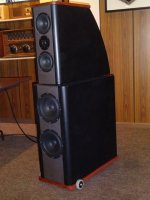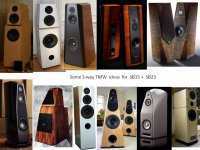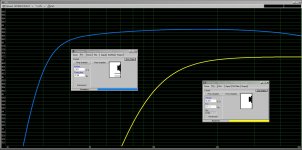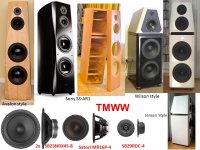I have to say, I'm finding more and more MTMWW designs and am rapidly leaning in that direction.
MTM --- WW Built by the Audio Society of Minnesota
Driver Complement:
Tweeter: SB29RDC-C000-4
Midwoofer: 2@ SB15NRX30-8
Woofer: 2@ SB23NRXS45-8
Full description and plans at this address:
https://sites.google.com/site/audiosocietyofminnesota/Home/diy-projects/sb-acoustics-reference
Attachments
That's a great find.. I couldn't see a link to the woofer performance though, but no reason to expect it to be much if any less than the 12" used in the zaph design.
Certainly it's looking more and more like a MTM-WW design is the way forward, as the WMTMW would be beautiful but probably lead to being single for a long time.... though that would give me more time to DIY so... yeah maybe 😉
As I said, I need to put some thought into the process of activating/deactivating the bass section, there's a chance I'd go for a digital version - i.e. with a DLCP if i can't make passive filters work... though I'm finding more and more things I like about the DLCP...
Certainly it's looking more and more like a MTM-WW design is the way forward, as the WMTMW would be beautiful but probably lead to being single for a long time.... though that would give me more time to DIY so... yeah maybe 😉
As I said, I need to put some thought into the process of activating/deactivating the bass section, there's a chance I'd go for a digital version - i.e. with a DLCP if i can't make passive filters work... though I'm finding more and more things I like about the DLCP...
You must make a decision between active crossovers vs. passive crossovers before you can make useful forward progress. Both digital and analog active crossovers offer delay blocks which remove any physical baffle requirements to time align driver wavefronts. Baffle edge diffraction, controlled directivity functions, and quarter-wave lobing rules still apply!
Then you can gather pictures of good designs to discuss at home to create your final sketch-up.
A well executed 3-driver, 3-way T-M-W still feels like the best balance for your current home/life requirements. You might find example passive Xovers if you use common SB15, SB23, SBtweet.
Then you can gather pictures of good designs to discuss at home to create your final sketch-up.
A well executed 3-driver, 3-way T-M-W still feels like the best balance for your current home/life requirements. You might find example passive Xovers if you use common SB15, SB23, SBtweet.
Attached a few pictures of TMW and MTM-WW speakers which might help your family discussions. WinISD plot of SB15 and SB23 illustrates how the +2db SPL advantage of the ported SB23 over the sealed SB15 could be used for baffle step compensation in a TMW.
WinISD sims show:
--- two SB23 woofers in a 5.3 cuft ported cabinet have F3 ~ 28Hz
--- two SB23 in a sealed 2.8cuft cabinet have F3 ~ 52Hz with Qtc = 0.7
--- two SB15 in a sealed 0.4cuft volume have F3 ~ 86Hz with Qtc=0.7
--------naturally, smaller volumes result in slightly higher F3
That's all I got.
WinISD sims show:
--- two SB23 woofers in a 5.3 cuft ported cabinet have F3 ~ 28Hz
--- two SB23 in a sealed 2.8cuft cabinet have F3 ~ 52Hz with Qtc = 0.7
--- two SB15 in a sealed 0.4cuft volume have F3 ~ 86Hz with Qtc=0.7
--------naturally, smaller volumes result in slightly higher F3
That's all I got.
Attachments
That's all I needed!
One of the main appeals of dual SB15NRXC30-8 was the increased sensitivity and ability to remove the need for a tweeter L pad altogether. Problem was I much preffered the aesthetic of a TMW. Plus, my listening room is never likely to be that small and amplification power, although a small problem now, won't be in the forseeable future.
It came down to running sims of TMW vs MTMWW, and the TMW won hands down, SB15's in parallel had a hideously low impedance, and had to be stabalised with series resistance. for me that blew the whole point of twin mids in the first place - it was mainly about the increase in efficiency. Even with large air cored 0.7mm inductors I still needed about 1R2 in series, switching to TMW everything just 'worked' better - impedance of the complete design is about 5-8 ohms rather than 4-5, and that 4 needed the 1R2... so decision is made, it'll be a SB23 ported 'stand' for the existing TM bookshelves. I'm sure I'll re-build it at a later date into something bigger (probably a MTMWW 3.5 way) but in the mean time this should give me all the extension and power I need in this little flat
One of the main appeals of dual SB15NRXC30-8 was the increased sensitivity and ability to remove the need for a tweeter L pad altogether. Problem was I much preffered the aesthetic of a TMW. Plus, my listening room is never likely to be that small and amplification power, although a small problem now, won't be in the forseeable future.
It came down to running sims of TMW vs MTMWW, and the TMW won hands down, SB15's in parallel had a hideously low impedance, and had to be stabalised with series resistance. for me that blew the whole point of twin mids in the first place - it was mainly about the increase in efficiency. Even with large air cored 0.7mm inductors I still needed about 1R2 in series, switching to TMW everything just 'worked' better - impedance of the complete design is about 5-8 ohms rather than 4-5, and that 4 needed the 1R2... so decision is made, it'll be a SB23 ported 'stand' for the existing TM bookshelves. I'm sure I'll re-build it at a later date into something bigger (probably a MTMWW 3.5 way) but in the mean time this should give me all the extension and power I need in this little flat
OK, spent a lot more time with this now. Looks like I'll need two 8" one 5" and the seas tweeter to get what I'm looking for, should be able to do it with 2nd order electrical xo's, a tweeter L pad and an LCR trap for the woofers.
With that in mind I'm going to leave this thread to die now whilst I work on cabinet designs and have them made, then I'll re-start a new thread and document the measurement/building process (don't want to go too far with simulations until I have actual drivers and in box measurements)
wish me luck... three ways are always that extra challenge!
With that in mind I'm going to leave this thread to die now whilst I work on cabinet designs and have them made, then I'll re-start a new thread and document the measurement/building process (don't want to go too far with simulations until I have actual drivers and in box measurements)
wish me luck... three ways are always that extra challenge!
TMWW common Klones of proven production speakers.Looks like I'll need two 8" one 5" and the seas tweeter to get what I'm looking for...
I don't think nannoo is planning side-side woofers.
Attachments
- Status
- Not open for further replies.
- Home
- Loudspeakers
- Multi-Way
- Calculations help for SB acoustics SB15NRXC30-8; ported or selaed?





